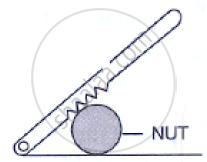Advertisements
Advertisements
प्रश्न
A cook used a ‘fire tong pair’ of length 32 cm. to lift a piece of burning coal of mass 500 g. If he applies his effort at a distance of 8 cm from the fulcrum, what is his effort? Assume friction etc. to be absent. Also, obtain values of the M.A. and the V.R. of this ‘machine’.
उत्तर
The ‘fire tong pair’ is a lever of class III in which the point of application of the effort is in between the load and the fulcrum. Hence, when friction, etc., are assumed absent, we have:
Effort × 8 cm = 0.5 kgf × 32 cm
Effort = `0.5 "kgf" × (32"cm")/(8"cm")`
= 2.0 kgf.
Thus, M.A. =`"Load"/"Effort"=0.5/2.0=1/4=0.25.`
Also, V.R. =`"Effort arm"/"Load arm"=(8"cm")/(32"cm")=0.25.`
APPEARS IN
संबंधित प्रश्न
Fill in the blank:
The useful work done by an actual machine is always ............ than the work done on the machine.
Define the term ‘work input’ and ‘work output’ in relation to a machine.
show a nut cracker In the diagram, mark the position of the fulcrum F and the line of action of load L and effort E .

State whether the mechanical advantage of an inclined plane is equal to 1, less than 2 or greater than 1?
Write the relation between mechanical advantage, velocity ratio and efficiency.
Write an expression for the mechanical advantage of an inclined plane.
A uniform metre scale is kept in equilibrium when supported at the 60 cm mark and a mass M is suspended from the 90 cm mark as shown in the figure. State with reasons, whether the weight of the scale is greater than, less than or equal to the weight of mass M.

Classify the following as a lever, a pulley and an inclined plane:
Nutcrackers
Which machine will you use to do the following work? Write their type.
To lift bricks to the top of a tall building.
Which machine will you use to do the following work? Write their type.
To draw water from a well.
